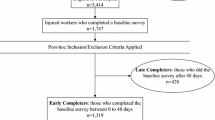Abstract
This is a retrospective case control study of the relationship between work pace of selectors at a food distribution center and the subsequent incidence of compensable back injuries. Subject employment records for 1 month were evaluated for degree of variation of actual-from-scheduled performance of weekly work pace as selectors, defined in terms of absolute values (either above or below criterion). Subjects were divided among those with no compensable claims for back injury (n=14) and those with multiple compensable claims (n=12) over a 2-year period of employment. Other dependent measures included percentage of tasks that each group completed by or before the scheduled criterion and the percentage of time working that employees engaged in selector activities. The groups differed in age, averaging 38 vs. 31 years for the no claims and multiple claims groups, respectively. The groups did not differ in terms of educational background or length of service at the food distribution center. The major finding was that there was a group difference in the actual-from-scheduled, absolute mean performance values. As expected, the multiple claims group had significantly more variability in their work pace than the no claims group. The no claims group also worked significantly more often at or faster than criterion and spent, on average, a higher percentage of their day performing selector duties. These preliminary results suggest an association between work patterns and occupational injury that warrant further research, such as a clinical trial manipulating the scheduled work criterion.
Similar content being viewed by others
References
Volinn E, Lai B, McKinney, S, Loeser JD. When back pain becomes disability: A regional analysis.Pain 1988; 33: 33–39.
Frymoyer JW, Pope MH, Clements JH, et al. Risk factors in low back pain: A cross-sectional epidemiologic study.J Bone Joint Surg 1983; 65: 213–218.
Roland M, Morris R. A study of the natural history of back pain. Part I. Development of a reliable and sensitive measure of disability in low-back pain.Spine 1983; 8: 141–144.
Webster BS, Snook SH. The cost of compensable low back pain.J Occup Med 1990; 32: 13–15.
Snook SH. Low back pain in industry. In White AA, Gordon SL eds.American Academy of Orthopaedic Surgeons Symposium idiopathic low back pain. St. Louis: C.V. Mosby Company, 1982, p. 23.
Anderson GBT. Epidemiologic aspects of low-back pain in industry.Spine 1981; 6: 53.
Kelsey JL, Githens PB, White AA, III, et al. An epidemiologic study of lifting and twisting on the job and risk for acute prolapsed lumbar intervertebral disc.J Orthop Res 1984; 2: 61.
Snook SH. Approaches to the control of back pain in industry: Job design, job placement and education/training. In Deyo RA, ed.,Occupational back pain. Philadelphia: Hanley & Belfus, 1987, pp. 45–59.
Worker's Compensation Division. Workers' Compensation statistics. Department of Industry, Labor and Human Relations, State of Wisconsin, 1978.
Arndt R. Work pace, stress, and cumulative trauma disorders.J Hand Surg. 1987; 12: 866–869.
Roy SH, DeLuca CJ, Casavant DA. Lumbar muscle fatigue and chronic low back pain.Spine 1989; 14: 992–1001.
Ahern DK, Follick MJ, Council JR, et al. Comparison of lumbar paravertebral EMG patterns in chronic low back pain patients and non-patient controls.Pain 1988; 34: 153–160.
Ahern DK, Hannon DJ, Goreczny, et al. Correlation of chronic low-back pain behavior and muscle function examination of the flexion-relaxation response.Spine 1990; 15: 92–95.
Eastman Kodak Company Ergonomics Group.Ergonomic design for people at work. Van Nostrand Reinhold, New York, 1986.
Report of the Quebec Task Force on Spinal Disorders.Spine 1987; 12(Suppl.): 512–515.
Bigos SJ, Battie MC, Spengler DM, et al. A prospective study of work perceptions and psychosocial factors affecting the report of back injury.Spine 1991; 16: 1–6.
Harshbarger D, Rose T. New possibilities in safety performance and the control of workers' compensation costs.J Occup Rehab 1991; 1: 133–143.
Komaki J, Barwick K, Scott L. A behavioral approach to occupational safety: Pinpointing and reinforcing safe performance in a food manufacturing plant.J Appl Psychol 1978; 62: 424–445.
Author information
Authors and Affiliations
Rights and permissions
About this article
Cite this article
Follick, M.J., Gorkin, L., Sylvia, S. et al. The relationship of work pace to back injury in a supermarket distribution center. J Occup Rehab 2, 183–190 (1992). https://doi.org/10.1007/BF01078996
Issue Date:
DOI: https://doi.org/10.1007/BF01078996




